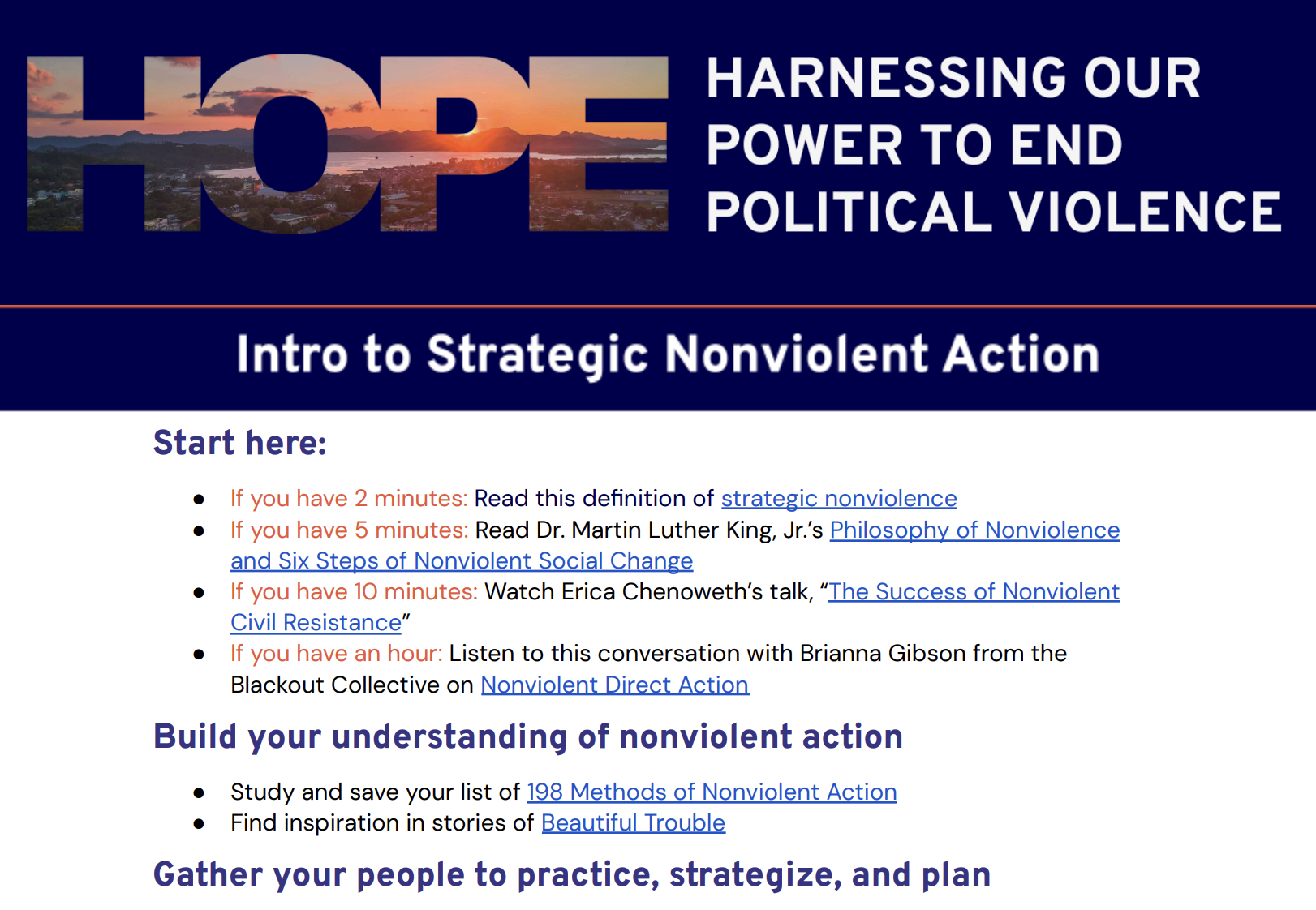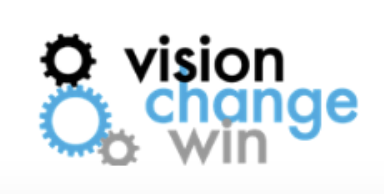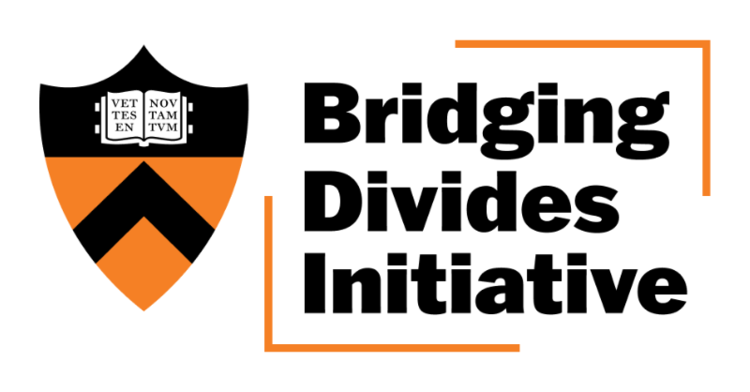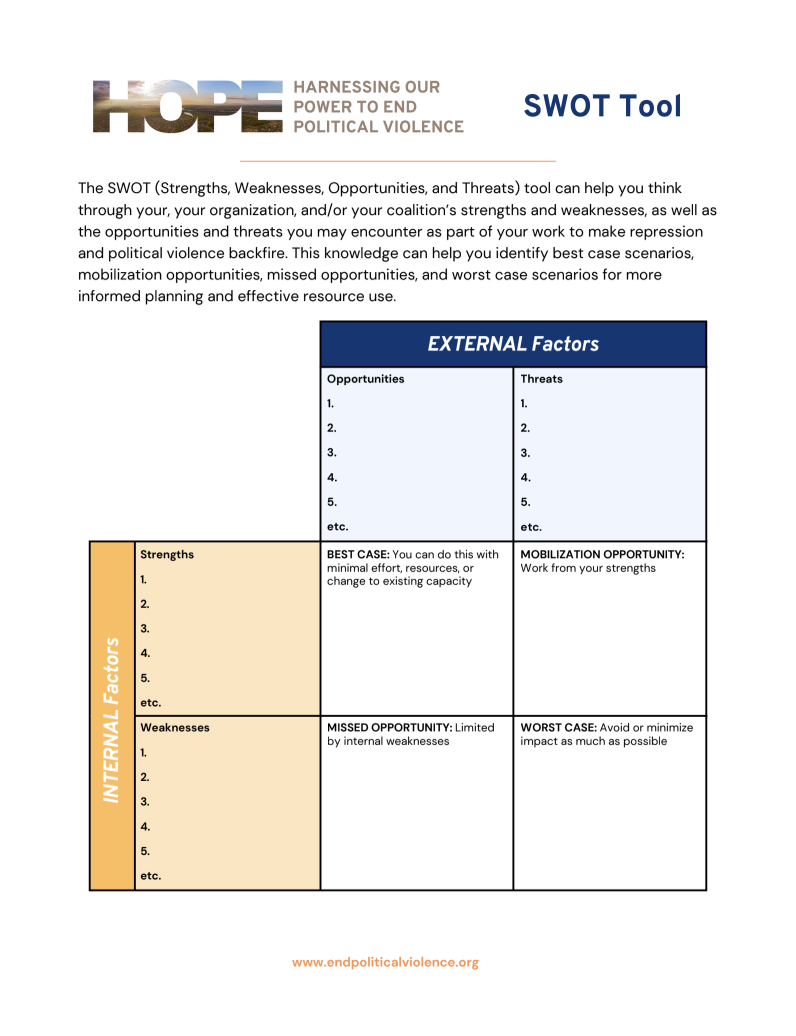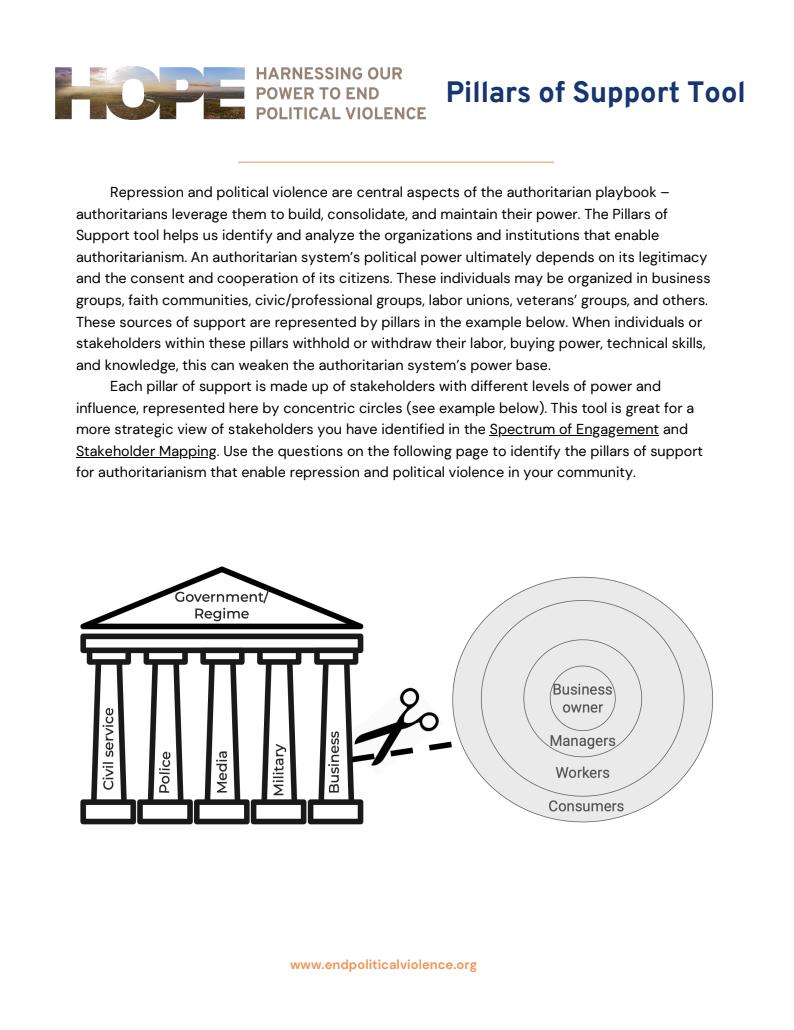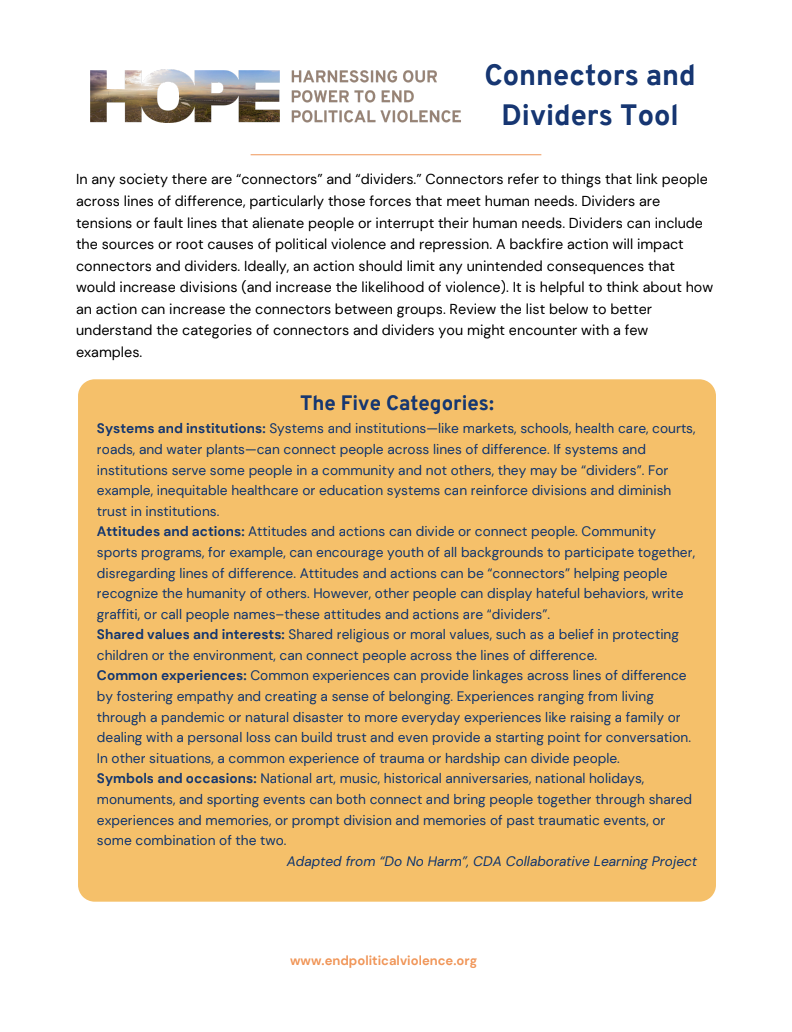FEATURED HOPE RESOURCES
WE OFFER TRAININGS TO HELP end Political violence.
Whether you or your group have experienced a threat or intimidation, you’re part of a group that is at high risk, or are concerned about political violence, we’re here to help you prepare so that you can stay safe and build support through creative action.
Our free trainings help you:
Better understand how political violence can show up in your own communities.
Learn how to identify and undermine political violence.
Awaken imagination about how we might respond in the face of threats or acts of political violence.
Develop skills and strategies to make political violence backfire and grow our power to end political violence.
FEATURED: related trainings and resources
The Get In Formation Training Series (G.I.F.T.S.) from Vision Change Win is a security and safety-focused training, with multiple levels of content for individuals and organizations to progress through.
Visit their website to register online.
The Bridging Divides Initiative’s Community Safety Directory lists de-escalation trainings available from organizations across the country.
Visit their interactive map to learn more.
Spectrum of Engagement
The Spectrum of Engagement tool helps us understand and grow the amount of people who believe repression and political violence have no place in our community and who are actively trying to counter it. People working to stop repression and political violence can make their efforts more effective by targeting specific individuals, groups, and organizations along this spectrum with actions that meet them where they are at.
backfire planning
Stakeholder Mapping
The Stakeholder Mapping tool helps you identify individuals, groups, and organizations who have a stake in keeping your community safe for everyone. It can provide insight into possible entry points for dialogue or coordination based on existing relationships, as well as new relationships that may need to be formed. It can also help you identify spoilers who benefit from repression and political violence and who may try to prevent stakeholder outreach and coordination.
Pillars of Support
English | Spanish
Repression and political violence are central aspects of the authoritarian playbook – authoritarians leverage them to build, consolidate, and maintain their power. The Pillars of Support tool helps us identify and analyze the organizations and institutions that enable authoritarianism. An authoritarian system’s political power ultimately depends on its legitimacy and the consent and cooperation of its citizens. These individuals may be organized in business groups, faith communities, civic/professional groups, labor unions, veterans’ groups, and others. These sources of support are represented by pillars in the example below. When individuals or stakeholders within these pillars withhold or withdraw their labor, buying power, technical skills, and knowledge, this can weaken the authoritarian system’s power base.
SWOT Analysis
The SWOT (Strengths, Weaknesses, Opportunities, and Threats) tool can help you think through your, your organization, and/or your coalition’s strengths and weaknesses, as well as the opportunities and threats you may encounter as part of your work to make repression and political violence backfire. This knowledge can help you identify best case scenarios, mobilization opportunities, missed opportunities, and worst case scenarios for more informed planning and effective resource use.
Connectors & Dividers
English | Spanish
In any society there are “connectors” and “dividers.” Connectors refer to things that link people across lines of difference, particularly those forces that meet human needs. Dividers are tensions or fault lines that alienate people or interrupt their human needs. Dividers can include the sources or root causes of political violence and repression. A backfire action will impact connectors and dividers. Ideally, an action should limit any unintended consequences that would increase divisions (and increase the likelihood of violence). It is helpful to think about how an action can increase the connectors between groups.
Organizing and Mobilizing to Action
English | Spanish
After completing the Spectrum of Engagement worksheet, use your answers to plan ways to organize or mobilize groups into action. Be as specific as possible when listing a specific group or individual. Some groups will be easier to activate than others. For example, already highly engaged people may be easier to reach and require fewer actions. However, if you are always activating the same group, you may not be able to expand your network.
Let us know How can we help
Use this form to tell us a little bit about what kind of training and support you need
WHAT YOU’LL LEARN
The goal backfire is to turn political violence into a turning point for freedom, dignity, and justice.
When the actions of those who enable, incite, and enact political violence actions are counterproductive for them,
their actions can be said to backfire.
The costs imposed on perpetrators can take two forms:
Direct losses—including a loss of political support, a loss of social standing, economic losses, and in some cases being held legally accountable.
Increasing support, power, and mobilization for campaigns for freedom, dignity, and justice.
5 PRINCIPLES
Making Political Violence Backfire
In order for injustice to backfire, it must be revealed.
Revealing can happen through research and other forms of evidence gathering, or through detailed interviews with people who have suffered abuse.
Sometimes revealing means creating conditions so that cover-up of a potential abuse is more difficult, such as when activists all carry cameras and plan ahead for sustained documentation of public actions.
The evidence of injustice must be presented in a way that seems credible and that actually gets distributed.
Counter devaluation by humanizing (redeeming) those who have been abused; this reduces the social distance between them and the broader audience.
Provide context and details about the targets’ lives
Elevate their positive values and actions
Have others (especially those in roles that the audience trusts and respects) speak up on their behalf
Anticipate devaluation by conducting advance training and adopting a code of conduct for political activities that inoculates targeted individuals from being provoked by perpetrators
Counter perpetrators’ attempts to reinterpret incidents of injustice by reframing them as unjust.
Document the impact of and damage from the abuse to help neutralize the perpetrators’ narratives
Communicate why the abuse was not justified and why it violates laws or widely held values
Communicate who should be held accountable for the abuse (for example, reframing abuse from an individual problem to a systemic problem)
Remember that while an injustice may seem obvious to activists, it should never be assumed that it is obvious to other audiences
When perpetrators try to divert action into official channels, redirect public outrage toward mobilization.
Remember that public or independent investigations tend to work slowly, focus on technical procedures, rely on experts, and give the appearance that justice will be done. This can result in decreased public mobilization, making inquiries less aggressive in pursuing the truth.
Backfire options include:
supporting the process
criticizing the process
making demands of the process
launching a parallel process
using the institutional process as a campaigning tactic
Resist threats and attempts to reward silence about injustice, turning these into catalysts for more backfire.
Attempts to inhibit public concern by threatening, bribing, intimidating, or otherwise co-opting those who speak out or organize against injustice may extend beyond targeted activists—sometimes perpetrators may further try to silence activists’ family, friends, and colleagues.
Anticipating intimidation and rewards, activists can warn their friends, families, and colleagues of such efforts, prepare to document these efforts, and develop strategies to make them backfire if or when they happen.
Being public about the fact that a group is prepared for threats may actually have a deterrent effect on perpetrators, making them aware ahead of time that such tactics will be used against them in “the court of public opinion,” and possibly also even a court of law.


